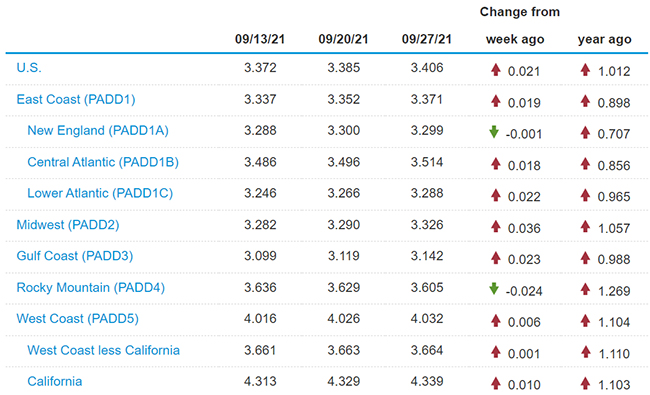Diesel Bumps Up 2.1¢ to $3.406 a Gallon

[Stay on top of transportation news: Get TTNews in your inbox.]
The national average price for diesel rose 2.1 cents to $3.406 a gallon, the first time it has eclipsed $3.40 in nearly seven years, according to Energy Information Administration data released Sept. 27.
Diesel last cost at least $3.40 a gallon on Dec. 15, 2014, when it was $3.419. Gasoline went in the other direction, falling nine-tenths of a cent to $3.175 a gallon. Still, that is $1.006 more than at this time in 2020.
Fuel surcharges are a common way fleets offset changes in fuel costs.
Diesel at a Glance
• Trucking’s main fuel increased for the fourth time in the past five weeks, totaling 8.2 cents.
• A gallon of diesel now costs $1.012 more than it did at this time last year.
• Diesel rose in eight of the 10 regions in EIA’s weekly survey, with the largest gain being 3.6 cents in the Midwest. The biggest drop was 2.4 cents in the Rocky Mountain region.
“UPS updates its fuel surcharge periodically to reflect the changes in the costs we incur for fuel and other operational costs to serve our customers,” Matthew O’Connor, senior manager of media relations at UPS Inc., told Transport Topics.
“The impact of these adjustments is included in the price we charge our customers,” he added.
Carbon Express CEO Steve Rush echoed the importance of having a fuel surcharge. He noted costs such as fuel and tolls are volatile and that industry stakeholders need to keep them separate and pass them through to customers, whether that be a broker or dealing direct.
“In the segment of the trucking industry that I’m in, which is tank truck, fuel has never really been an issue on our side because we get our fuel surcharge on every single load we do,” Rush told TT. “I hate that fuel is going up as high as it is, but it’s a pass-through, and in my opinion, if you don’t pass it through, you’re your own worst enemy.”

Rush
Rush has concerns over the indirect effects of how increased fuel costs could impact the general economy and therefore his Wharton, N.J.-based business.
“I have deep concerns,” Rush said. “We just can’t keep going this way. Who’s going pay for this? I mean, before you know it, our dollar is going to be like the peso in Mexico. This is insanity.”
The United Kingdom is facing a worse situation in terms of fuel availability. BP and ExxonMobil warned Sept. 23 that they were having to close some gas stations as a result of a truck driver shortage in the country. Long lines have formed at some gas stations, and the British army has been called upon to help out.
“You see the pictures that are coming out of Europe now, and you hear about the crazy high natural gas prices, the very high diesel prices and the lack of availability of gasoline in some places,” Tom Kloza, founder of the Oil Price Information Service, told TT. “That can transfer some sentiment where people say, ‘Is this going to happen in the United States?’ I think the answer is no.”

Kloza
He suspects diesel prices may move a little higher and gasoline prices could waffle a bit. But generally, he noted, they will persist around their current elevated levels for now.
“We’re not really seeing the surge in diesel demand,” Kloza said. “There’s all sorts of analysis and papers being written about the price of natural gas. I’m not making these numbers up, but on an oil equivalent basis, we’ve seen it sell on the European continent and in Asia for something like the equivalent of $150 a barrel.”
Kloza added there has been concern over fuel switching this winter, meaning people who normally would use natural gas, for example, switching to oil because of availability or cost. He noted that has been a catalyst for the price of diesel worldwide. But he is optimistic things won’t get that bad with the caveat of this winter being worse than normal.
“It’s almost as though the market right now is pricing it at a colder than normal winter, which would have consequences,” Kloza said. “Mostly for Europe, but also for the U.S. We may see some fuel switching if there is natural gas curtailments in the U.S. But that might be a 50-50 proposition at best, and it’s as though the market currently is pricing it as a 100% proposition.”
U.S. On-Highway Diesel Fuel Prices

EIA.gov
Want more news? Listen to today's daily briefing below or go here for more info:

